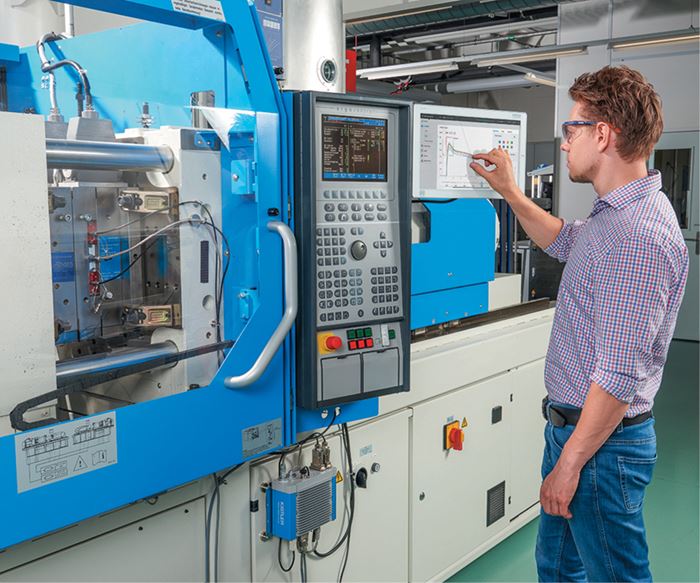INJECTION MOLDING: New Monitors, Controls, Sensors
New capabilities include the OPC-UA interface for Industry 4.0 communications.
Two well-known suppliers of injection monitoring and control systems and sensors introduced several new and upgraded products at the K 2016 show in Dusseldorf in October. The Swiss parent of Kistler Instrument Corp., Amherst, N.Y., brought out ComoNeo 2.0, a brand-new version of the ComoNeo process monitoring system introduced at Fakuma 2015 (see Feb. ’16 Keeping Up), which itself was an enhanced successor to Kistler’s Como Injection system. ComoNeo 2.0 adds automatic process control to the monitoring functions. It controls the switchover point from speed to pressure control in mold filling within each cycle, based on cavity-pressure signals, and analyzing the difference between current and reference pressure curves. The switchover point can be set manually or determined automatically by the system through analyzing a sequence of five test cycles.
Also new in ComoNeo 2.0 is a Restart Assistant, a “wizard” that helps re-establish the process after a mold is moved to a different press. It analyzes the difference between current and reference pressure curves to offer the user suggestions on how to optimize the process—for example, “Please change holding pressure to 500 bars (7255 psi).” The process is iterative, requiring a couple of test cycles.
ComoNeo 2.0 also now incorporates the OPC-UA (Open Platform Communication Universal Architecture) interface that is becoming the standard for Industry 4.0 machine-to-machine data connectivity. This enables the ComoNeo system to fully implement Multiflow control—automatic hot-runner balancing by adjusting tip temperatures—without the need for a separate PC. It also can “talk” to higher-level MES and ERP computer systems.
A second major introduction for Kistler was the ComoDataCenter 3.1, a new version of the central monitoring system for all Como Injection—and now ComoNeo—systems plantwide. It now stores all mold settings centrally. It also now offers the same user interface as ComoNeo and will translate input from older Como Injection systems to the new interface. Both types of systems are now linked by a common database. Extended functionality includes more detailed good/bad part analysis, with ability to zero in on any cycle and the pressure curve for each cavity. It also provides cpK values for the process.
Kistler also has a new piezoelectric pressure sensor, Type 6185, which measures only 2 mm frontal diam. and is insensitive to the position in which it is installed. This eliminates the susceptibility to inaccurate measurements due to mounting tolerances, making installation by moldmakers much easier and more reliable.
Kistler also brought out the Type 1722 multichannel connector, which simplifies connection of single-wire coaxial cables.
Meanwhile, Priamus of Switzerland (U.S. office in Brunswick, Ohio), showed several updated injection monitoring/control products. Under the banner of “Quality 4.0,” Priamus has added an OPC-UA interface to its FillControl systems, which allows it to transmit quality data from an entire molding cell to a network via an MES system. At the show, Priamus demonstrated this connectivity with the authentig MES system from T.I.G. of Austria, recently acquired by Engel.
Priamus also has enhanced the Q-Button on its FillControl systems. When a user has established a process that produces good parts, pushing the Q-Button automatically sets the six-sigma SPC limits for key process variables. In its latest iteration, the button establishes three levels of limits—pre-warning, warning, and alarm—to alert the user to process drift well before bad parts are produced.
A new portable FillControl system allows monitoring the process by means of a large tablet computer that plugs into the sensors on the machine and mold. All the required cables,
amplifiers, and power supply are housed in the transport case. Also new is FillControl V for automatic balancing of valve gates. It detects the arrival of the melt front via in-cavity temperature sensors, thereby detecting the different filling times from cavity to cavity. The Priamus system calculates the optimized settings of the pin stroke for every cycle and transmits them to the valve controller via an interface. FillControl V can work with the valve-gate controls of sister company Synventive Molding Solutions, another member of the Barnes Group to profile the opening speed as well as timing of the valve pins. For cold-runner LSR molding with valve gates, the Priamus system has worked successfully with the Servo Shot system of ACH Hefner of Austria.
Related Content
How to Set Barrel Zone Temps in Injection Molding
Start by picking a target melt temperature, and double-check data sheets for the resin supplier’s recommendations. Now for the rest...
Read MoreHow to Stop Flash
Flashing of a part can occur for several reasons—from variations in the process or material to tooling trouble.
Read MoreKnow Your Options in Injection Machine Nozzles
Improvements in nozzle design in recent years overcome some of the limitations of previous filter, mixing, and shut-off nozzles.
Read MoreAre Your Sprue or Parts Sticking? Here Are Some Solutions
When a sprue or part sticks, the result of trying to unstick it is often more scratches or undercuts, making the problem worse and the fix more costly. Here’s how to set up a proper procedure for this sticky wicket.
Read MoreRead Next
How Polymer Melts in Single-Screw Extruders
Understanding how polymer melts in a single-screw extruder could help you optimize your screw design to eliminate defect-causing solid polymer fragments.
Read MoreLead the Conversation, Change the Conversation
Coverage of single-use plastics can be both misleading and demoralizing. Here are 10 tips for changing the perception of the plastics industry at your company and in your community.
Read MoreAdvanced Recycling: Beyond Pyrolysis
Consumer-product brand owners increasingly see advanced chemical recycling as a necessary complement to mechanical recycling if they are to meet ambitious goals for a circular economy in the next decade. Dozens of technology providers are developing new technologies to overcome the limitations of existing pyrolysis methods and to commercialize various alternative approaches to chemical recycling of plastics.
Read More




























